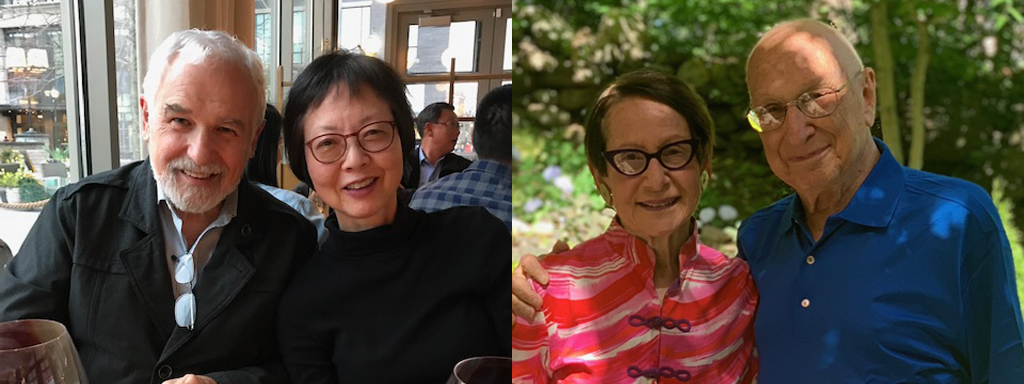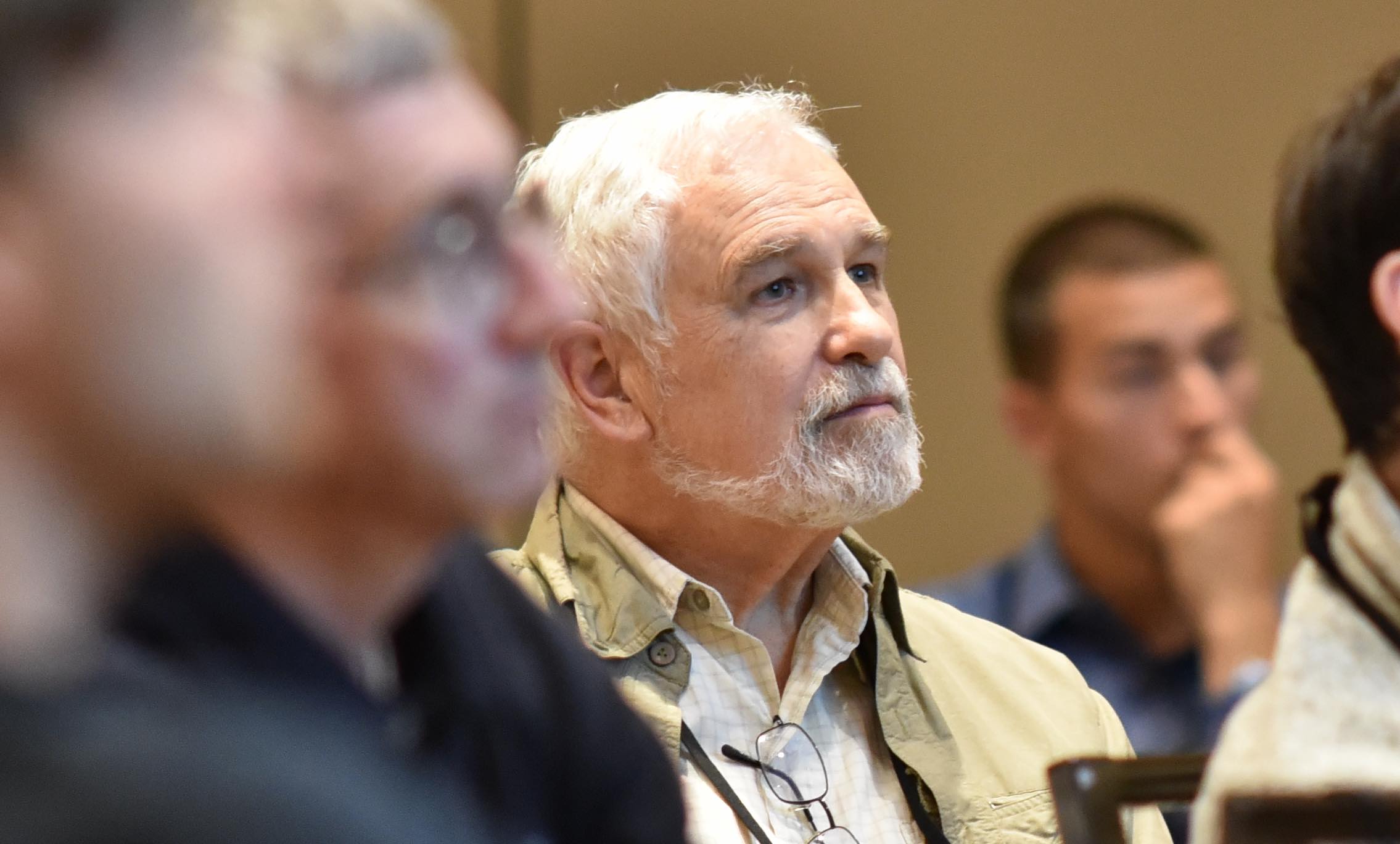David Galas is a Renaissance man: a physicist turned molecular biologist who paints scenes from nature and publishes lyrical poetry.
He is a visionary, developing technology 20 years ago that was the backbone of a COVID-19 rapid-response test created by Abbott Labs. In the 1990s, while at the helm of the Department of Energy’s Human Genome Project, he discovered the SOST gene, which led to an osteoporosis medication, and he developed footprinting, an influential lab technique. In subsequent years, he discovered the gene for early-onset Alzheimer’s disease and was awarded numerous patents for increasing bone density.
Simultaneously, Galas has worked tirelessly to advance the Hertz Foundation’s mission—as an interviewer of Hertz Fellowship candidates for nearly 50 years, a board member for more than two decades, and chairman of the board of directors since 2008. After leading the foundation through the most transformative years since its founding, Galas is transitioning to chairman emeritus this spring.
Scientific odyssey
Galas’s odyssey as a scientist began when he was a boy roaming the verdant fields of Englefield Green, a village 20 miles west of London. “The village was just across the river from Windsor Castle in a lovely part of the country,” Galas recalled. “My friends and I were interested in nature and spent hours walking in the woods and fields. It started out with birds and then extended to other creatures and plants and everything.”
Though biology might have been an obvious direction, Galas was born in 1944, when physicists were viewed as rock stars. “I was fascinated by the scientists who were involved in the Manhattan Project and who ended World War II,” he said. “Scientists, particularly physicists, had the reputation of making a huge difference in the world.”
While Galas was in grade school, he was further influenced by his father, who began teaching physics and chemistry at West Point Military Academy. “I used to stop by his building, and he would show me experiments that he had demonstrated to the students that day. In grade school, I started getting college-level instruction because I was interested,” he said.
By the time Galas started high school, he was hooked on physics. He received his AB in physics in 1967 from the University of California, Berkeley, and his MS in 1968 and PhD in 1972 from the University of California, Davis-Livermore. Toward the end of Galas’s undergraduate studies, he took a zoology course.
“I had a marvelous professor who introduced me to molecular biology, which I had never heard of,” Galas said. “He planted a seed.”
Shifting interests
While in graduate school for theoretical physics, Galas moonlighted in a molecular biologist’s lab most evenings. He also picked up Nobel laureate James Watson’s 1965 book, The Molecular Biology of the Gene, devouring it over the course of a couple of days. “I was absolutely fascinated by genes’ potential power. It was eye-opening, and the beginning of my interest in molecular biology,” he said.
At the urging of his professor, renowned physicist and then Hertz Foundation board member Edward Teller, Galas applied for and received a Hertz Foundation fellowship in 1968. Following graduation, he accepted a position as a scientific advisor to the Defense Science Board’s Task Force on Strategic Vulnerability and began working with physicist-turned-molecular-biologist Elbert Branscomb at the Lawrence Livermore National Laboratory. His interest in molecular biology continued to grow during his postdoctoral studies. In 1977, he worked in the Harvard lab of Walter Gilbert, who had just developed one of the first methods for sequencing DNA, which earned him the Nobel Prize in 1980. Galas then worked under Jeffrey Miller at the University of Geneva in Switzerland, first as a postdoc and later as a member of the research faculty.
In Geneva, Galas began laying the groundwork for the footprinting technique, “an important tool in the search for our understanding of nucleic acid-protein interactions,” he wrote in his 2001 article The Invention of Footprinting. The technique enables researchers to discover the precise binding site of a protein on DNA using benchtop methods only.
Leaving Geneva for the faculty of University of Southern California (USC), where he was associate professor, Galas worked on transposable genetic elements in bacteria. “I became interested in the structure of bacterial genomes and the notion that these moveable genes could shuffle and move pieces of DNA around in genomes,” he said.
In 1985, while at USC, he attended a meeting at the University of California, Santa Cruz, to discuss sequencing the human genome. “That was the first time I’d heard it discussed,” Galas said. “I became very, very interested, not as a possibility of sequencing the genome, but about going after genome structures as being fundamentally important to understanding biology.”
The Human Genome Project
What finally drew Galas into the genome program was a 1988 National Academy of Science meeting that endorsed the idea of sequencing the entire human genome. Galas received a call from the Department of Energy (DOE), which had a small genome portfolio as part of its Health and Environmental Research program. The DOE asked him to lead a committee to make recommendations on what they should do with its biological and environmental research component. His recommendations included expanding its genome research program. By then, Congress had funded both the NIH and the DOE to undertake the Human Genome Project, and by 1990 the initial planning stage was complete.
Although Galas initially declined the DOE’s request to direct the office and implement the committee’s recommendations, he later relented and moved to Washington, D.C., where he renewed his acquaintance with James Watson, who headed the genome office at the National Institutes of Health. Many years before, Galas had cold-called Watson from his hotel room in Cambridge to ask about transitioning from physics to genomics and the two chatted for hours. When Watson resigned and Francis Collins assumed leadership of the project, Galas met with him weekly to impart political wisdom. “Francis had never been in Washington and didn’t know much about how politics worked,” Galas said.
After three years at the DOE, Galas returned to the private sector to direct research and development efforts at Darwin Molecular Corporation (which later became Chiroscience), one of many new companies formed to pursue commercial opportunities arising from genome research.
Lasting influence
Galas’s work with the Human Genome Project ultimately influenced the direction of the Hertz Foundation and its support of PhD candidates in the biological sciences—an area that previously was not considered for fellowship support. At the board’s invitation, Galas made a persuasive presentation, and the foundation began funding biology fellows in the late 1990s.
In 1999, Galas was asked to join the board, and in 2008, he became chair, a role that would have a transformational effect. “The foundation was doing a great job in the sense that the fellows were having an impact, but there were so few of them, depending on what we could afford,” Galas said.
To raise more money for fellowships, Galas decided the Hertz Foundation needed to move from being a private foundation to a public foundation, a goal that was accomplished in 2010. Since then, gifts have grown steadily nearly every year, from less than $2 million in 2013 to a high of $6 million in 2019. Today, annual support steadily tops more than $4 million, despite a worldwide pandemic. Partnerships with like-minded organizations have grown as well, with over 40 fellowships supported by individuals and organizations such as the Bill & Melinda Gates Foundation, Google, Draper, and The Hertz Corporation.
Galas also reorganized the board to play to members’ strengths. Some board members focused on fundraising while others became part of the council, responsible for overseeing the interviews, the fellowship selection process, and volunteer work with the Hertz community. Under Galas’s leadership, fellows’ engagement with the foundation has grown exponentially, with more than 50 fellows engaged in the fellowship selection process or as directors or council members. Known as the “Hertz Community,” the fellowship program has expanded into a robust lifelong engagement opportunity, offering fellows ways to engage at every age and stage of their careers, including through internships, mentorship, and opportunities for research collaboration.
Galas’s focus in recent years has been to make sure others have the opportunity to shape the future of science and technology. He and his wife, Diane Isonaka, support two fellowships. In 2020, board member Harold Newman and his wife, Ruth Newman, renamed the entrepreneurial initiative they established in 2012 in honor of Galas’s many contributions to the Hertz Foundation. The initiative, which provides investments of up to $25,000 and professional support to Hertz Fellows who propose the most innovative entrepreneurial projects, with particular emphasis on collaboration among fellows, is now called the Harold Newman and David Galas Entrepreneurial Initiative.

Although he is moving to chairman emeritus, Galas plans to remain involved in the foundation, as well as the microbiology industry. Today, his lab at the Pacific Northwest Research Institute focuses on computational biology and on developing laboratory technical methods like RNA sequencing. He and his colleagues are developing a first-of-its-kind algorithm based on information theory to find subtle relationships among multiple variables, such as genetic variants, clinical information, ancestry, and lifestyle data.
“Trying to understand the multiplicities in the genome is complex and there are many kinds of interactions,” he said. “This is the work of the next decade in genetics.”


